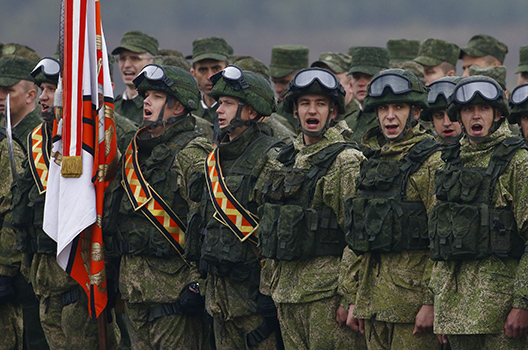Moscow will soon orchestrate yet another major military exercise, this time in its Eastern Military District (EMD)—a vast 2.7-million-square-mile territory stretching from its Siberian Arctic shores down to Vladivostok on the Pacific, close to Russia’s borders with China and North Korea. This will come exactly one year after its Zapad-17 exercise across Russia’s Western Military District, just on NATO’s doorstep.
While far from the Alliance’s borders this time, the forthcoming event’s location, huge scale, and unusual partner participation (China) carry strategic implications for NATO and the West, and also raise serious questions open to diverse interpretation.
As reported by the TASS news agency, Russian Defense Minister Sergei Shoygu announced on September 4 that the exercise, dubbed Vostok 2018, will be the largest in Russia’s modern history—one harking back in its scale to the Soviet Union’s military preparations of the Cold War 1980s.
According to Shoygu, some 300,000 troops, 1,000 air platforms (airplanes, helicopters, and drones), up to eighty combat and logistic ships, and as many as 36,000 tanks, armored personnel carriers, and other vehicles will be deployed during Vostok-18 across five proving grounds, four air force and air defense sites, and around the Japan, Bering, and Okhotsk seas.
Just as exceptionally, he said a contingent of 3,500 military personnel from China’s People’s Liberation Army will also participate in Vostok-18’s main scenario at the EMD’s Tsugol proving ground, located about 100 miles north of where the borders of Russia, China, and Mongolia converge.
TASS said Shoygu expected the whole endeavor “to enhance the level of field, naval, and air training of the personnel and practice operations in the eastern military direction and crucial sea and ocean areas.”
If Shoygu’s numbers are correct, Vostok-18’s scale will dwarf that of Zapad-17. Whether those numbers hold true is another matter.
As one NATO official put it to me on September 6, “Russia was less than transparent about Zapad’s actual size and scope. It was supposed to be around 12,000 troops in the Western District only, but the activity stretched all the way down to the Black Sea region and we think the real numbers were more like 70,000-80,000 troops. If it under-reported Zapad, could it be over-reporting Vostok to magnify the strategic effect?”
Assessing what takes place during Vostok-18 will be a challenge for the Alliance. Far removed from NATO’s home territory, the exercise falls outside the remit of the Treaty on Conventional Armed Forces in Europe (CFE) and its pre-notification and reporting rules for exercises by either NATO or Russia.
Paradoxically, the allies have been pre-briefed about the faraway Vostok event better than they were for the nearby Zapad. Russia’s military delegation to NATO consulted the latter, which “didn’t provide all the granular details but it was better than the briefings we got prior to Zapad. Also, there’s been a barrage of reporting about Vostok and that has helped fill in the picture as well,” observed the NATO official. Moreover, Shoygu openly instructed Chief of Russia’s General Staff Gen. Valery Gerasimov and other high-ranking officials to brief foreign military attaches accredited in Moscow, “including those from NATO countries,” about the exercise.
By contrast, Russia dragged its feet in 2017 until the last minute when Zapad participant Belarus hurriedly invited allied officials and other observers for a very limited briefing just a few days before the exercise launched.
Despite Vostok-18’s greater transparency, the exercise throws up a major challenge for NATO to carry out what it calls “focused intelligence gathering,” or the ability to generate, collate, and fuse intelligence in real time for a 360-degree strategic view of its security environment. Zapad was a first test of that new objective, but the EMD one will be much harder given that NATO’s ISR (intelligence, surveillance, and reconnaissance) assets are mainly in Europe. The Alliance will have to rely heavily on the national intelligence of just a few allies and notably the United States.
Just as tricky will be to assess the rationale underlying Vostok-18 and its scenarios, particularly in view of those participating Chinese troops. Whatever the more ostensibly cooperative gestures between Russia and China of late, the countries have had a long record of prickly political and military relations.
The fictional target countries in Zapad’s war vignettes turned out to suspiciously resemble the profile of certain allies. But it seems inconceivable, even in hybrid warfare terms, that Russia would factor a fictional enemy resembling China into a scenario while inviting the latter to join in as an exercise partner.
So, what could it mean?
“Vostok’s scale suggests a strategic exercise on multiple fronts designed to test and prove the ability of Russia to move its assets quickly from one place to another,” said the NATO official.
If so, that would send another saber-rattling mobility signal not only westwards to NATO—“See? We can do the same thing at the other end of our huge territory”—but also eastwards to Beijing.
History has shown time and again that large military powers adjacent to one another rarely form friendly or lasting alliances. Mutual wariness is the rule.
What better way to show a wary neighbor what you are eating than to invite them to your table?
Brooks Tigner reports on EU and NATO foreign, defense, and security policy from Brussels, where he has separated reality from rhetoric for the past twenty-five years. You can follow him on Twitter @BrooksTigner.
Image: Russian servicemen stand in line during the Zapad 2017 war games at a range near the town of Borisov, Belarus September 20, 2017. (REUTERS/Vasily Fedosenko)
